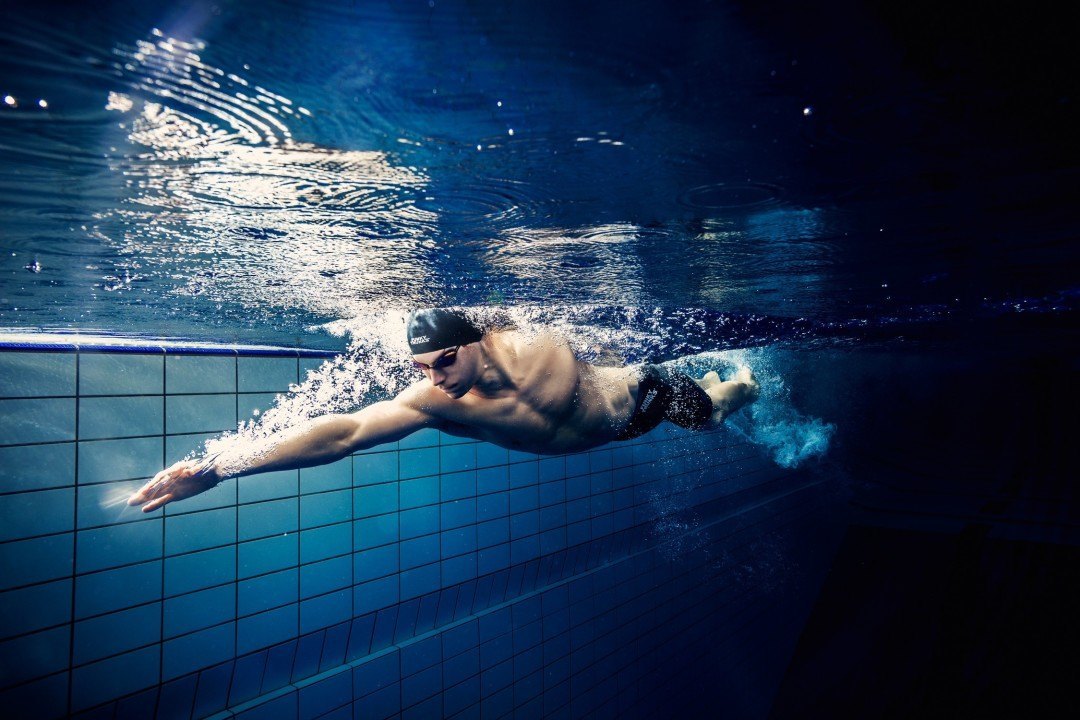Courtesy of Gary Hall Sr., 10-time World Record Holder, 3-time Olympian, 1976 Olympic Games US Flagbearer and The Race Club co-founder.
I want to bring your attention to two common, but not widely recognized, problems of the kicking motion that adversely affect kicking speed. Neither is related to propulsion, but both are related to frontal drag.
- Slow transition time from down kick to up kick
- Drawing the legs forward on the up kick too aggressively
In freestyle, after the down kick, a swimmer will often relax the foot before initiating the next up kick. By relaxing the foot, it will hang down toward the bottom and cause as much as a 40% increase in frontal drag. In swimming, within hundredths of a second, a swimmer can change from quick acceleration to dramatic deceleration because of an adverse body position, like the hanging foot. A fast kicker transitions from their down kick to up kick quickly, avoiding the hanging foot.
Most of the propulsion that occurs from the foot in either the down or up kick occurs very early in the motion. After the initial snap of the foot backward on the down kick, most of the propulsion is over. The motion of the foot from that point is downward and then forward, providing lift, but little or no propulsion. Similarly, the propulsion that occurs during the up kick occurs at the beginning of the motion, as the foot first enters the stream of the vortex.
During the up kick, a fast kicker should bend the knee to around 60 degrees or less to limit frontal drag. If the swimmer draws the foot up and forward too aggressively during this motion, he causes more frontal drag resulting in more deceleration. Therefore, the motion of the foot needs to be very fast at the beginning of the up kick, with short transition time between down and up kick, but not too fast on the up kick once the propulsive phase is over.
Think of your kick in the same way that I operate my boat in the Florida Keys when trying to get it up on a plane. I pop the throttle all the way down, then back off the throttle as the boat comes up. While kicking, pop the throttle at the beginning of the down and up kick, but then back off the throttle after the initial snap down or up. If you keep the throttle down too long, in either direction, you actually decelerate faster.
Sound complicated? Well, it is and that is why we don’t see that many really fast kickers. To do so requires great plantar flexibility, great strength of core and legs, fitness and the knowledge and experience of when and how to move the feet and legs.
A fast kick is the way to a fast swim…so that is why at The Race Club, we focus on developing a lot on kicking speed and propulsion, like in this video.
Yours in Swimming,
Gary Sr.

Gary Hall, Sr., Technical Director and Head Coach of The Race Club (courtesy of TRC)
Read Part I: Getting the Motion Right
Read Part II: The Importance of the Up Kick
Like The Race Club on Facebook
Follow The Race Club on Instagram
Follow The Race Club on Twitter
Connect to The Race Club / Gary Hall Sr. on Linkedin
THE RACE CLUB
 Because Life is Worth Swimming, our mission is to promote swimming through sport, lifelong enjoyment, and good health benefits. Our objective is for each member of and each participant in The Race Club to improve his or her swimming performances, health, and self-esteem through our educational programs, services and creativity. We strive to help each member of The Race Club overcome challenges and reach his or her individual life goals.
Because Life is Worth Swimming, our mission is to promote swimming through sport, lifelong enjoyment, and good health benefits. Our objective is for each member of and each participant in The Race Club to improve his or her swimming performances, health, and self-esteem through our educational programs, services and creativity. We strive to help each member of The Race Club overcome challenges and reach his or her individual life goals.
The Race Club, logo The Race Club provides facilities, coaching, training, technical instruction, video, fitness and health programs for swimmers of all ages and abilities. Race Club swim camps are designed and tailored to satisfy each swimmer’s needs, whether one is trying to reach the Olympic Games or simply improve one’s fitness. Our programs are suitable for beginner swimmers, pleasure swimmers, fitness swimmers, USA swimming or YMCA swimmers, or triathletes; anyone who wants to improve swimming skills. All of our Race Club members share an enjoyment of being in the water and use swimming to stimulate a more active mind and body.
